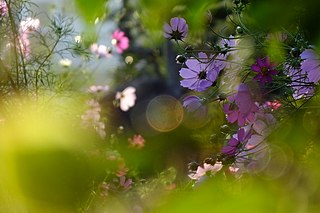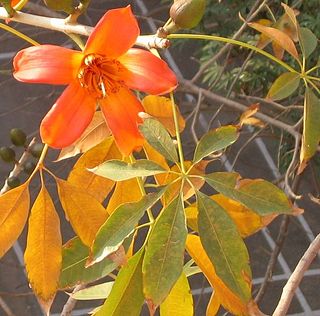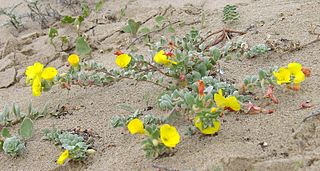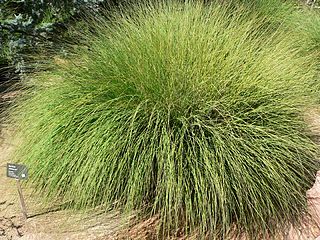Related Research Articles

Smilax is a genus of about 300–350 species, found in the tropics and subtropics worldwide. In China for example about 80 are found, while there are 20 in North America north of Mexico. They are climbing flowering plants, many of which are woody and/or thorny, in the monocotyledon family Smilacaceae, native throughout the tropical and subtropical regions of the world. Common names include catbriers, greenbriers, prickly-ivys and smilaxes. Sarsaparilla is a name used specifically for the Jamaican S. ornata as well as a catch-all term in particular for American species. Occasionally, the non-woody species such as the smooth herbaceous greenbrier are separated as genus Nemexia; they are commonly known by the rather ambiguous name carrion flowers.

Buddleja is a genus comprising over 140 species of flowering plants endemic to Asia, Africa, and the Americas. The generic name bestowed by Linnaeus posthumously honoured the Reverend Adam Buddle (1662–1715), an English botanist and rector, at the suggestion of Dr. William Houstoun. Houstoun sent the first plants to become known to science as buddleja to England from the Caribbean about 15 years after Buddle's death.

Cosmos is a genus, with the same common name of cosmos, consisting of flowering plants in the sunflower family.

Dioscorea is a genus of over 600 species of flowering plants in the family Dioscoreaceae, native throughout the tropical and warm temperate regions of the world. The vast majority of the species are tropical, with only a few species extending into temperate climates. It is named by the monk Charles Plumier after the ancient Greek physician and botanist Dioscorides.

Cercocarpus, commonly known as mountain mahogany, is a small genus of at least nine species of nitrogen-fixing flowering plants in the rose family, Rosaceae. They are native to the western United States and northern Mexico, where they grow in chaparral and semidesert habitats and climates, often at high altitudes. Several are found in the California chaparral and woodlands ecoregion.

Bombax is a genus of mainly tropical trees in the mallow family. They are native to western Africa, the Indian subcontinent, Southeast Asia, and the subtropical regions of East Asia and northern Australia. It is distinguished from the genus Ceiba, which has whiter flowers.

Carl Sigismund Kunth, also Karl Sigismund Kunth or anglicized as Charles Sigismund Kunth, was a German botanist. He is known for being one of the first to study and categorise plants from the American continents, publishing Nova genera et species plantarum quas in peregrinatione ad plagam aequinoctialem orbis novi collegerunt Bonpland et Humboldt.

Iva annua, the annual marsh elder or sumpweed, is a North American herbaceous annual plant in the sunflower family that was historically cultivated by Native Americans for its edible seed.

Camissoniopsis cheiranthifolia, the beach suncup or beach evening primrose, is a species of the evening primrose family and is native to open dunes and sandy soils of coastal California and Oregon.

Lippia is a genus of flowering plants in the verbena family, Verbenaceae. It was named after Augustus Lippi, (1678-1705), a French naturalist and botanist. He was killed in Abyssinia. The genus contains roughly 200 species of tropical shrubs that are found around the world. Plants are fragrant due to their essential oils, which vary between species but may include estragole, carvacrol, linalool, or limonene. The leaves of certain species, such as L. graveolens, can be used as a culinary herb similar to oregano.

Phyla nodiflora, the frog fruit, sawtooth fogfruit, or turkey tangle, is an ornamental plant in the family Verbenaceae, and is native to the area between the north of South America to the southern United States. It can be found in tropical areas around the globe, a naturalized species in many places. This plant is cited in Flora Brasiliensis by Carl Friedrich Philipp von Martius.

Iva is a genus of wind-pollinated plants in the daisy family, described as a genus by Linnaeus in 1753. Plants of this genus are known generally as marsh elders. The genus is native to North America.

Muhlenbergia is a genus of plants in the grass family.

Sporobolus is a nearly cosmopolitan genus of plants in the grass family. The name Sporobolus means "seed-thrower", and is derived from Ancient Greek word σπόρος (spóros), meaning "seed", and the root of βάλλειν (bállein) "to throw", referring to the dispersion of seeds. Members of the genus are usually called dropseeds or sacaton grasses. They are typical prairie and savanna plants, occurring in other types of open habitat in warmer climates. At least one species is threatened with extinction, and another is extinct.

Eleocharis is a virtually cosmopolitan genus of 250 or more species of flowering plants in the sedge family, Cyperaceae. The name is derived from the Greek words ἕλειος (heleios), meaning "marsh dweller," and χάρις (charis), meaning "grace." Members of the genus are known commonly as spikerushes or spikesedges. The genus has a geographically cosmopolitan distribution, with centers of diversity in the Amazon Rainforest and adjacent eastern slopes of the South American Andes, northern Australia, eastern North America, California, Southern Africa, and subtropical Asia. The vast majority of Eleocharis species grow in aquatic or mesic habitats from sea level to higher than 5,000 meters in elevation.

Sporobolus virginicus, known by numerous common names including seashore dropseed, marine couch, sand couch, salt couch grass, saltwater couch, coastal rat-tail grass, and nioaka, is a species of grass with a wide distribution.
Ambrosia cheiranthifolia is a rare species of flowering plant known by the common names South Texas ambrosia and Rio Grande ragweed. It is native to the coast of South Texas and the Mexican states of Tamaulipas and Coahuila. It occurs in coastal prairie, grassland, and mesquite shrubland habitat. It has declined because its native habitat has been cleared for development, with remaining open savanna invaded by non-native grasses such as buffelgrass. Today there are perhaps 20 populations remaining, but some of these may have very few genetic individuals because the species is clonal, with many cloned plants attached by one rhizome. It is not certain that the plant still exists in Mexico. This is a federally listed endangered species of the United States.
References
- ↑ The Plant List, Iva cheiranthifolia Kunth
- ↑ "Iva cheiranthifolia". Natural Resources Conservation Service PLANTS Database. USDA . Retrieved 7 August 2015.
- ↑ Tropicos, Iva cheiranthifolia Kunth